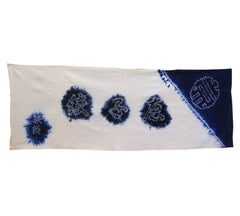A Meiji Era Tenugui: Rare and Interesting Shibori
late nineteenth, early twentieth century
13 1/2" x 36", 34 cm x 91.5 cm
This is a tenugui or a traditional cotton hand towel that is ubiquitous in Japan.
This one is special because unlike most tenugui which are stencil dyed this one is dyed in beautifully-done, selectively hand dip dyed indigo --and it is old, it dates to the Meiji period.
On the right we see a wedge containing a stylized kanji or Chinese character. In the center of the cloth are three kanji in a row. A fourth kanji is located near the bottom, left hand corner of the tenugui. The three central kanji seem to be dyed in natural indigo while the kanji on the left and the right corner are probably dyed in synthetic indigo.
The shibori on this tenugui is so well done--and this one is part of a group of variations that will be offered here over time--that it seems to suggest that the kanji represent a shop name might have been from a shibori dyer, a yukata broker or some other trade that relates to cloth and shibori. This piece is almost assuredly from Narumi/Arimatsu, a booming and powerful center of shibori production and brokering.
A tenugui is a traditional cotton hand towel that is ubiquitous in Japan because of its many uses. It can be used to mop sweat from a brow in summer; it can be worn on the head, kerchief-like, while working; it can be twisted and worn as a sweat band like sushi chefs do: there are endless ways to use a tenugui.
Sometimes these lengths of cotton are used by stores as a give away, sometimes as gifts at new year, other time for store promotions. Sometimes tenugui are brought back from trips as souvenirs if they are imprinted with a specialized image specific to certain region or town.
No matter its origin or original purpose this is a very handsome one, rare for its expert shibori dying and for its artful composition.
Recommended.


